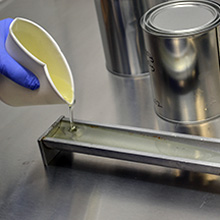Epoxy compounds are used to cast various shapes and sizes of components. Although epoxies are relatively simple to use, there are some basic steps that must be followed to establish a trouble free casting operation.
Epoxy casting compounds must be carefully selected to suit the application at hand. The following are the basic considerations for selecting an appropriate epoxy compound:
- Processing limitations
- Tool (mould) design
- Viscosity
- Reactivity
- Exotherm
- Vapour pressure
- Shrinkage
- Expansion characteristics
- Thermal shock capabilities
- Thermal stability characteristics
Processing limitations
Consideration must be given to the availability of appropriate processing equipment. Epoxy systems are available to suit hand casting, automated casting, heat curing and higher temperature (oven) curing. Epoxy compounds may contain fillers or may be unfilled liquids.
Tool (mould) design
The following are the basic considerations for tool design in casting with epoxy compounds:
- The pour hole should be located for the shortest path into the cavity being filled.
- Provide vent openings to allow air to escape as the epoxy fills the cavity. Air vents should be provided for all areas where air might be trapped such as flat surfaces and around intricate inserts.
- A reservoir of material should be available to draw from as the epoxy shrinks during the gellation process. Most often the reservoir will be located over the pour hole which is usually the largest opening into the mould.
- Avoid sharp corners and undercuts wherever possible as these are areas conducive to air entrapment.
- Provide uniform wall thickness (mass) throughout the tool to allow for uniform heating and to prevent large temperature variations due to different rates of cooling.
Viscosity
The lower the mixed viscosity the easier it is to process the epoxy. The mixed viscosity of two component epoxy compounds can be reduced significantly by separately heating the resin and hardener prior to mixing together or warming the mixture itself.
Storing materials containing fillers under heat will require constant agitation to prevent filler settling and the possibility of an off ratio mix. Heating will normally result in shorter pot life.
Reactivity
"For every 10oC rise in temperature the reaction rate doubles" This means that for every 10oC rise in temperature, the pot life (the time during which the mixture remains pourable) is reduced by (half) 50%. For example; if an epoxy system is formulated to gel (become firm) in 30 minutes at 25oC (77oF), then if warmed to 35oC (95oF) it will gel in approximately 15 minutes.
Exotherm
Exotherm is the heat generated by the compound, above the cure temperature, during the reaction. The amount of heat (exotherm) generated depends on the epoxy formulation and the (mass) amount of product being reacted at one time. The exotherm generated by resins and/or hardeners heated to reduce the viscosity will be greater than without the application of heat. As a general rule, fast reacting epoxy systems generate higher exotherm during the reaction.
Vapour pressure
If a curing epoxy system becomes too hot, it will generate gas bubbles which, if the bubbles form just before gellation (hardening), can become trapped in the structure. Vapour pressure is also a key consideration for the use of vacuum to remove air from the epoxy mixture. Certain key ingredients such as accelerators or portions of the curing agent itself can be stripped out of the mixture under vacuum.
Shrinkage
Shrinkage is the reduction in volume during cure. Excessive shrinkage will cause internal stresses and serious degradation in the performance of the solidified epoxy. Epoxy systems containing fillers shrink less than unfilled epoxies. As a rule, the higher the filler content the lower the shrinkage. Providing a reservoir of product to replenish the shrinking epoxy improves the end result.
Thermal expansion characteristics
This must be considered especially if the casting contains embedded component such as inserts within the cured epoxy. Large differences between the expansion characteristics of the epoxy and the embedded inserts can be the cause of cracking and reduced thermal cycling abilities. In general, the more flexible the cured epoxy the more it will expand and the higher the filler content the lower the rate of expansion.
Thermal shock capabilities
The higher the elongation capabilities of the cured epoxy the better the thermal shock capabilities. Unfortunately, highly flexibilized systems exhibit rather poor thermal stability. The epoxy system must be formulated to achieve a suitable compromise between cured hardness, tensile strength and elongation to achieve the desired characteristics for the application.
Thermal stability
The thermal stability of a cured epoxy system is its ability to operate at elevated temperature while maintaining a specified set of minimum properties. A common test method to determine thermal stability is % weight loss in a period of time at a given temperature.
Since every manufacturing process is somewhat unique and the parts manufactured must meet different performance requirements, it is not possible to provide hard and fast rules that could apply to all processes and materials. The following is a general set of trade-offs caused by specific changes in the handling of epoxy compounds:





